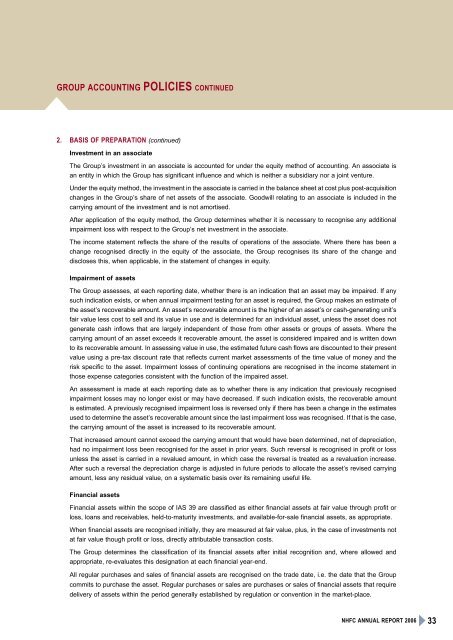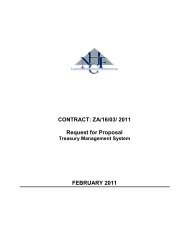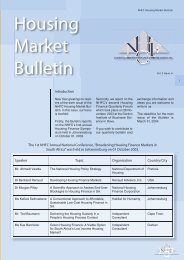housing - National Housing Finance Corporation
housing - National Housing Finance Corporation
housing - National Housing Finance Corporation
You also want an ePaper? Increase the reach of your titles
YUMPU automatically turns print PDFs into web optimized ePapers that Google loves.
GROUP ACCOUNTING POLICIES CONTINUED<br />
2. BASIS OF PREPARATION (continued)<br />
Investment in an associate<br />
The Group’s investment in an associate is accounted for under the equity method of accounting. An associate is<br />
an entity in which the Group has significant influence and which is neither a subsidiary nor a joint venture.<br />
Under the equity method, the investment in the associate is carried in the balance sheet at cost plus post-acquisition<br />
changes in the Group’s share of net assets of the associate. Goodwill relating to an associate is included in the<br />
carrying amount of the investment and is not amortised.<br />
After application of the equity method, the Group determines whether it is necessary to recognise any additional<br />
impairment loss with respect to the Group’s net investment in the associate.<br />
The income statement reflects the share of the results of operations of the associate. Where there has been a<br />
change recognised directly in the equity of the associate, the Group recognises its share of the change and<br />
discloses this, when applicable, in the statement of changes in equity.<br />
Impairment of assets<br />
The Group assesses, at each reporting date, whether there is an indication that an asset may be impaired. If any<br />
such indication exists, or when annual impairment testing for an asset is required, the Group makes an estimate of<br />
the asset’s recoverable amount. An asset’s recoverable amount is the higher of an asset’s or cash-generating unit’s<br />
fair value less cost to sell and its value in use and is determined for an individual asset, unless the asset does not<br />
generate cash inflows that are largely independent of those from other assets or groups of assets. Where the<br />
carrying amount of an asset exceeds it recoverable amount, the asset is considered impaired and is written down<br />
to its recoverable amount. In assessing value in use, the estimated future cash flows are discounted to their present<br />
value using a pre-tax discount rate that reflects current market assessments of the time value of money and the<br />
risk specific to the asset. Impairment losses of continuing operations are recognised in the income statement in<br />
those expense categories consistent with the function of the impaired asset.<br />
An assessment is made at each reporting date as to whether there is any indication that previously recognised<br />
impairment losses may no longer exist or may have decreased. If such indication exists, the recoverable amount<br />
is estimated. A previously recognised impairment loss is reversed only if there has been a change in the estimates<br />
used to determine the asset’s recoverable amount since the last impairment loss was recognised. If that is the case,<br />
the carrying amount of the asset is increased to its recoverable amount.<br />
That increased amount cannot exceed the carrying amount that would have been determined, net of depreciation,<br />
had no impairment loss been recognised for the asset in prior years. Such reversal is recognised in profit or loss<br />
unless the asset is carried in a revalued amount, in which case the reversal is treated as a revaluation increase.<br />
After such a reversal the depreciation charge is adjusted in future periods to allocate the asset’s revised carrying<br />
amount, less any residual value, on a systematic basis over its remaining useful life.<br />
Financial assets<br />
Financial assets within the scope of IAS 39 are classified as either financial assets at fair value through profit or<br />
loss, loans and receivables, held-to-maturity investments, and available-for-sale financial assets, as appropriate.<br />
When financial assets are recognised initially, they are measured at fair value, plus, in the case of investments not<br />
at fair value though profit or loss, directly attributable transaction costs.<br />
The Group determines the classification of its financial assets after initial recognition and, where allowed and<br />
appropriate, re-evaluates this designation at each financial year-end.<br />
All regular purchases and sales of financial assets are recognised on the trade date, i.e. the date that the Group<br />
commits to purchase the asset. Regular purchases or sales are purchases or sales of financial assets that require<br />
delivery of assets within the period generally established by regulation or convention in the market-place.<br />
NHFC ANNUAL REPORT 2006 33






